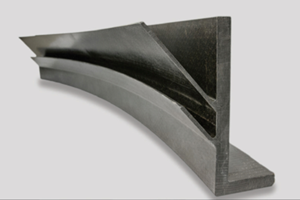A technological brake for the carbon supply roller coaster?
Henrik Olofsson is a co-founder and the business development manager of Oxeon AB (Västra Frölunda, Sweden). He holds an MS in mechanical engineering from Chalmers University of Technology and a BS in business economics and management from the School of Economics and Commercial Law, Gothenburg University (both in
I have followed with interest the discussions regarding affordable PAN-based carbon fiber supply. I believe there is a possible way to increase aerospace-grade carbon fiber output without making large investments in new production facilities.
As noted in previous issues of High-Performance Composites, the production mix is one of the most important factors affecting carbon fiber output. Fiber producers have to set off valuable resources to produce 6K, 3K and even 1K small tows instead of maximizing output by producing 12K. From discussions I've had with many industry players, I understand that the main reason to use a small tow is the thinner and lighter areal weight characteristics it brings to a woven fabric. Compared to a 12K woven fabric, a smaller tow fabric has the advantages of lower areal weight and less crimp (i.e., waviness) in the structure and, therefore, improved surface smoothness and better mechanical performance in a composite structure.
But a woven fabric made from fibrous tapes, instead of smaller tows or yarns, has those same advantages. Dr. Nandan Khokar, cofounder and R&D manager of Oxeon AB, during his work at Chalmers University of Technology (Gothenburg, Sweden), developed a patented weaving technology that processes 20-mm to 50-mm (0.79-inch to 1.97-inch) wide warp and weft spread carbon fiber tapes to produce fabrics. Large tows, such as 12K or 24K, are spread into flat tapes — the wider the spread, the thinner the tape, with a corresponding decrease in areal weight. When a woven reinforcement is made by weaving spread tows or tapes instead of standard tows, the incidence of crimp is significantly reduced. A test carried out by the University in partnership with the Swedish Institute of Composites (SICOMP) compared a traditional fabric produced from 3K tows and a tape-woven fabric produced from spread 12K tows. The mechanical performance of the tape fabric was shown to be better than the 3K fabric. Fiber properties of the 3K and 12K carbon were identical. Others have observed similar results and resulting improved performance, such as that presented at Aeronautics Forum at this year's JEC Composites Show in Paris, in "Thin Ply Technology for More Effective & Optimum Design." Presented by Stephen W. Tsai, professor emeritus of Stanford University, the paper was encouraging in that Prof. Tsai indicated qualification of spread tape woven materials is underway and may not be prohibitively expensive.
Several material suppliers have produced similar woven tape products and converted them into prepregs, including Cytec Engineered Materials Inc. (Tempe, Ariz.), Toray Composites America Inc. (Tacoma, Wash.) and Hexcel (Dublin, Calif.). Cytec's material, woven by Fabric Development Inc. (Quakertown, Pa.), was impregnated with a PEEK thermoplastic resin and used for landing gear doors and access panels on the F-22. Toray's T700S 12K plain-weave fabric has the same areal weight as a 3K fabric, and also is pre-impregnated with an epoxy resin and used extensively in the general aviation market. Hexcel's product is available as a 177°C-/350°F-cure prepreg. More recently, a Japanese company named Technomax has developed a method of spreading fibers with ultrasonic energy and weaving the resulting spread fibers in an economical way, with an eye toward producing recyclable thermoplastic prepregs.
Economically, the method holds promise if tows can be both spread and woven quickly and efficiently. Unlike traditional weaving, tape weaving requires no setting equipment and setup time is significantly reduced, in my experience. Production rates are higher because warp and weft tapes are four to ten times wider than 12K tow. More importantly, fiber producers can increase output using existing facilities by producing more 12K tows instead of the smaller sizes. The investment in a fiber spreading line is insignificant compared to investment in a new carbon fiber production plant. Fiber producers could spread the tows directly as they emerge from the spinerettes and thereby add greater value to the spread tow product without major capital investments.
I invite carbon fiber producers to consider this approach. It could not only help maintain consistent carbon fiber supply for the entire industry, but also improve mechanical performance of woven materials in high-performance applications using a lower-cost fiber. In this way we may be able to reduce the "roller coaster" effect of past fiber shortages and cost increases.
Related Content
CAMX 2022 exhibit preview: Bally Ribbon Mills
Bally Ribbon Mills’ highlights its capabilities in design and manufacture of woven structural shapes for hybrid composite structures used in aerospace applications.
Read MoreThe making of carbon fiber
A look at the process by which precursor becomes carbon fiber through a careful (and mostly proprietary) manipulation of temperature and tension.
Read MoreComposite resins price change report
CW’s running summary of resin price change announcements from major material suppliers that serve the composites manufacturing industry.
Read MoreCAMX 2022 exhibit preview: Parabeam
Parabeam’s 3D E-glass woven fabrics, particularly ParaGlass and ParaTank, continue to advance composite sandwich structures with high flexibility, strength and application versatility.
Read MoreRead Next
Composites end markets: Energy (2024)
Composites are used widely in oil/gas, wind and other renewable energy applications. Despite market challenges, growth potential and innovation for composites continue.
Read MoreFrom the CW Archives: The tale of the thermoplastic cryotank
In 2006, guest columnist Bob Hartunian related the story of his efforts two decades prior, while at McDonnell Douglas, to develop a thermoplastic composite crytank for hydrogen storage. He learned a lot of lessons.
Read MoreCW’s 2024 Top Shops survey offers new approach to benchmarking
Respondents that complete the survey by April 30, 2024, have the chance to be recognized as an honoree.
Read More











.jpg;maxWidth=300;quality=90)









